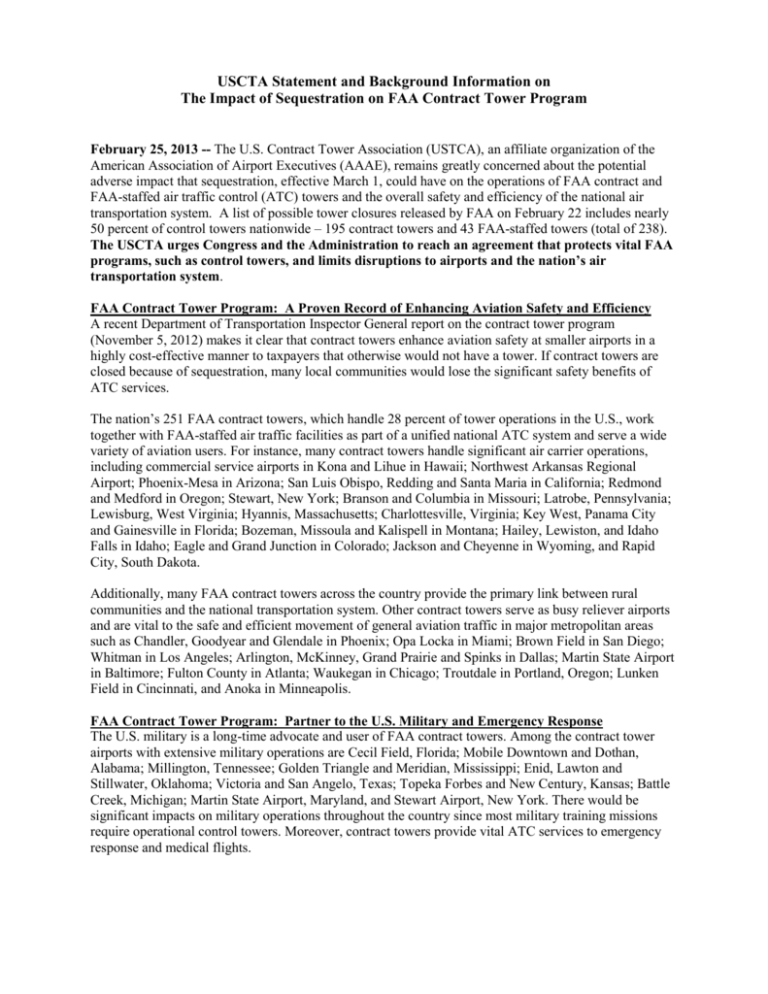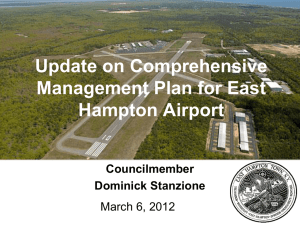here
advertisement

USCTA Statement and Background Information on The Impact of Sequestration on FAA Contract Tower Program February 25, 2013 -- The U.S. Contract Tower Association (USTCA), an affiliate organization of the American Association of Airport Executives (AAAE), remains greatly concerned about the potential adverse impact that sequestration, effective March 1, could have on the operations of FAA contract and FAA-staffed air traffic control (ATC) towers and the overall safety and efficiency of the national air transportation system. A list of possible tower closures released by FAA on February 22 includes nearly 50 percent of control towers nationwide – 195 contract towers and 43 FAA-staffed towers (total of 238). The USCTA urges Congress and the Administration to reach an agreement that protects vital FAA programs, such as control towers, and limits disruptions to airports and the nation’s air transportation system. FAA Contract Tower Program: A Proven Record of Enhancing Aviation Safety and Efficiency A recent Department of Transportation Inspector General report on the contract tower program (November 5, 2012) makes it clear that contract towers enhance aviation safety at smaller airports in a highly cost-effective manner to taxpayers that otherwise would not have a tower. If contract towers are closed because of sequestration, many local communities would lose the significant safety benefits of ATC services. The nation’s 251 FAA contract towers, which handle 28 percent of tower operations in the U.S., work together with FAA-staffed air traffic facilities as part of a unified national ATC system and serve a wide variety of aviation users. For instance, many contract towers handle significant air carrier operations, including commercial service airports in Kona and Lihue in Hawaii; Northwest Arkansas Regional Airport; Phoenix-Mesa in Arizona; San Luis Obispo, Redding and Santa Maria in California; Redmond and Medford in Oregon; Stewart, New York; Branson and Columbia in Missouri; Latrobe, Pennsylvania; Lewisburg, West Virginia; Hyannis, Massachusetts; Charlottesville, Virginia; Key West, Panama City and Gainesville in Florida; Bozeman, Missoula and Kalispell in Montana; Hailey, Lewiston, and Idaho Falls in Idaho; Eagle and Grand Junction in Colorado; Jackson and Cheyenne in Wyoming, and Rapid City, South Dakota. Additionally, many FAA contract towers across the country provide the primary link between rural communities and the national transportation system. Other contract towers serve as busy reliever airports and are vital to the safe and efficient movement of general aviation traffic in major metropolitan areas such as Chandler, Goodyear and Glendale in Phoenix; Opa Locka in Miami; Brown Field in San Diego; Whitman in Los Angeles; Arlington, McKinney, Grand Prairie and Spinks in Dallas; Martin State Airport in Baltimore; Fulton County in Atlanta; Waukegan in Chicago; Troutdale in Portland, Oregon; Lunken Field in Cincinnati, and Anoka in Minneapolis. FAA Contract Tower Program: Partner to the U.S. Military and Emergency Response The U.S. military is a long-time advocate and user of FAA contract towers. Among the contract tower airports with extensive military operations are Cecil Field, Florida; Mobile Downtown and Dothan, Alabama; Millington, Tennessee; Golden Triangle and Meridian, Mississippi; Enid, Lawton and Stillwater, Oklahoma; Victoria and San Angelo, Texas; Topeka Forbes and New Century, Kansas; Battle Creek, Michigan; Martin State Airport, Maryland, and Stewart Airport, New York. There would be significant impacts on military operations throughout the country since most military training missions require operational control towers. Moreover, contract towers provide vital ATC services to emergency response and medical flights. Program Cuts From Sequestration Could Negatively Impact Safety Should sequestration occur and contract towers close (even temporarily), there would be severe operational impacts on the national aviation system. First and foremost, tower controllers give first priority to separating aircraft and issuing safety and weather alerts. Without controllers in the tower, no one will be performing these critical safety functions. Additionally, in most cases, the Class D airspace assigned to the contract tower locations would revert to Class E airspace. When this occurs, the overlying radar facility (terminal or enroute FAA facilities) would then be responsible for the operations normally worked by the contract towers. As such, workloads would increase dramatically for FAA facilities at the very same time those facilities will be facing the possibility of reduce staffing due to sequestration. These developments would have a significant negative safety and efficiency impact on the ATC system nationwide. Also, air traffic controllers are the first line of defense for pilots and passengers in the event of an aircraft accident. Tower controllers are likely to be the first to know of an aircraft in distress, and they become the focal point for a rapid and effective emergency response. Furthermore, many contract towers have flight schools. Student pilots must conduct portions of their training at airports with a tower. Closing contract towers will force these students to fly into busier airports, introducing slow-flying student piloted aircraft into the busy environment of larger commercial airports that will decrease the efficiency of these operations and negatively impact safety. FAA contract tower communities desire and deserve the safety benefits that these facilities provide. We urge Congress and FAA to continue their support of this successful partnership that FAA, airports, contract controllers, ATC contractors, FAA controllers and aviation users have developed over the past three decades. For Further Information: Contact Spencer Dickerson of AAAE/USTCA at 703/824-0500, ext. 130; sdickerson@aaae.org






